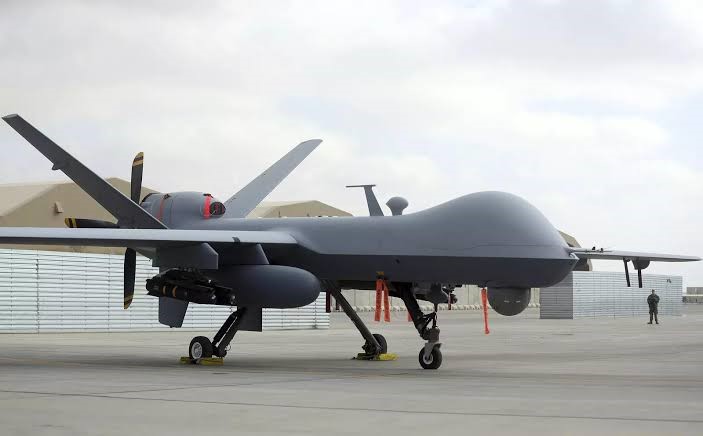MQ-9 Reaper UAVs

Disclaimer: Copyright infringement not intended
Context: Ahead of Prime Minister Narendra Modi’s visit to the U.S. The Defence Acquisition Council approved the procurement of 31 armed MQ-9 Reaper Unmanned Aerial Vehicles (UAVs) from General Atomics.
More about the deal
- The deal will be executed through the Foreign Military Sales route of the U.S. government.
- Of the 31 UAVs to be procured, 15 are meant for the Navy and eight each for the Army and Air Force.
- The total cost, estimated at more than $3 billion, also includes the maintenance, overhaul and repair of the platforms
About General Atomics MQ-9 Reaper
- The General Atomics MQ-9 Reaper, which is also called Predator B, is an unmanned aerial vehicle (UAV).
- It is capable of remotely controlled or autonomous flight operations.
- It has been developed by General Atomics Aeronautical Systems (GA-ASI) for the United States Air Force (USAF).
- Hindustan Aeronautics Ltd. (HAL) and General Atomics last year announced that the turbo-propeller engines which power the MQ-9 would be supported by HAL’s engine division for the Indian market.
Importance of the deal
- It will significantly enhance the maritime surveillance capability of the Indian Navy over the Indian Ocean Region.
- They will reduce the stress on the P-8I maritime patrol aircraft.
- India is also the first non-treaty partner to be offered a Missile Technology Control Regime Category-1 Unmanned Aerial System – the Sea Guardian UAS manufactured by General Atomics.
India-US defence relations
The total defence trade between the US and India grew from near zero in 2008 to over $20 billion in 2020.
- Free and open Indo-Pacific: India plays a vital role in achieving our shared vision for a free and open Indo-Pacific. In 2019, Bangladesh, Sri Lanka and India became eligible for funding under DoD’s Maritime Security Initiative, which is an initiative to conduct capacity-building programmes in the Indo-Pacific.
- Framework agreements: The Logistics Exchange Memorandum of Agreement (LEMOA), the Communications, Compatibility and Security Agreement (COMCASA), and the Industrial Security Agreement (ISA) are now in place.
- Foreign Military Sales (FMS) and Direct Commercial Sales (DCS): S.-India defence sales are being facilitated through both the Foreign Military Sales (FMS) and Direct Commercial Sales (DCS) processes. MH-60R Seahawk helicopters ($2.8 billion), Apache helicopters ($796 million), and the Large Aircraft Infrared Countermeasure ($189 million) were made through FMS.
- Since 2015, India has been authorised by the US over $3 billion in defence articles via the DCS process, which licences the export of defence equipment, services, and related manufacturing technologies controlled under the 21 categories of the U.S.
- India as Major Defense Partner : The United States designated India as a Major Defense Partner in 2016. In 2018, India was elevated to Strategic Trade Authorization tier 1 status, allowing India to receive license-free access to a wide range of military technologies of the Department of Commerce.
- Together at UN Peacekeeping: From 2016 to 2019, India and the United States jointly taught the UN Peacekeeping Course for African Partners. These courses were conducted in New Delhi They were co-sponsored by the U.S. Global Peace Operations Initiative, and taught by U.S., Indian, and African course alumni.
- Military Exercises: In November 2019, the United States and India conducted Tiger Triumph, the first-ever tri-service (ground, naval, and air forces) exercise between the two countries. India also participates in the U.S.-led Rim of the Pacific (RIMPAC) exercise and the trilateral Malabar exercise with the United States and Japan.
- Defence Technology and Trade Initiative (DTTI) : India and the United States have launched a Defence Technology and Trade Initiative (DTTI) aimed at simplifying technology transfer policies and exploring possibilities of co-development and co-production to invest the defence relationship with strategic value.
Conclusion
Defence relations between India and the US are growing to new heights. However, they have minor differences over various issues. India must maintain its defence relations by ensuring self-interest and strategic autonomy.
|
PRACTICE QUESTIONS Consider the following statements about The ship named MQ-9 Repaer:
Which of the above statements are correct? Ans: 2 |
https://epaper.thehindu.com/ccidist-ws/th/th_delhi/issues/39875/OPS/GS2BC40LH.1+G5KBC4NF6.1.html





1.png)
